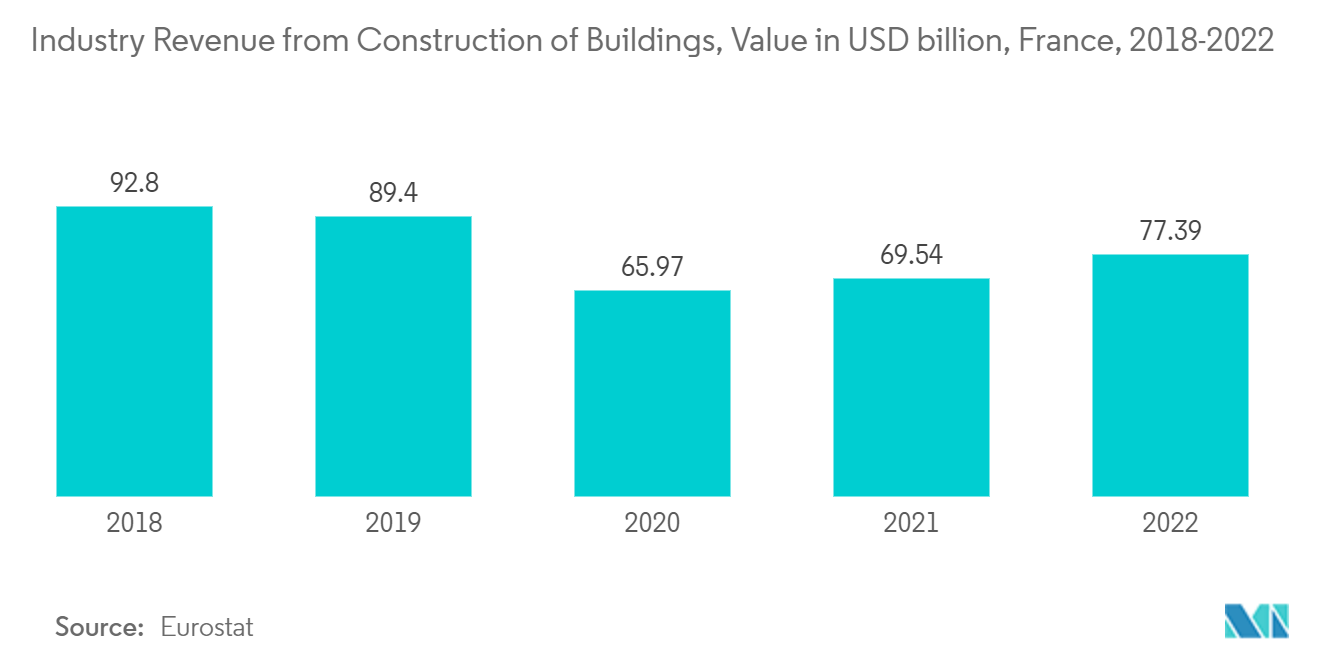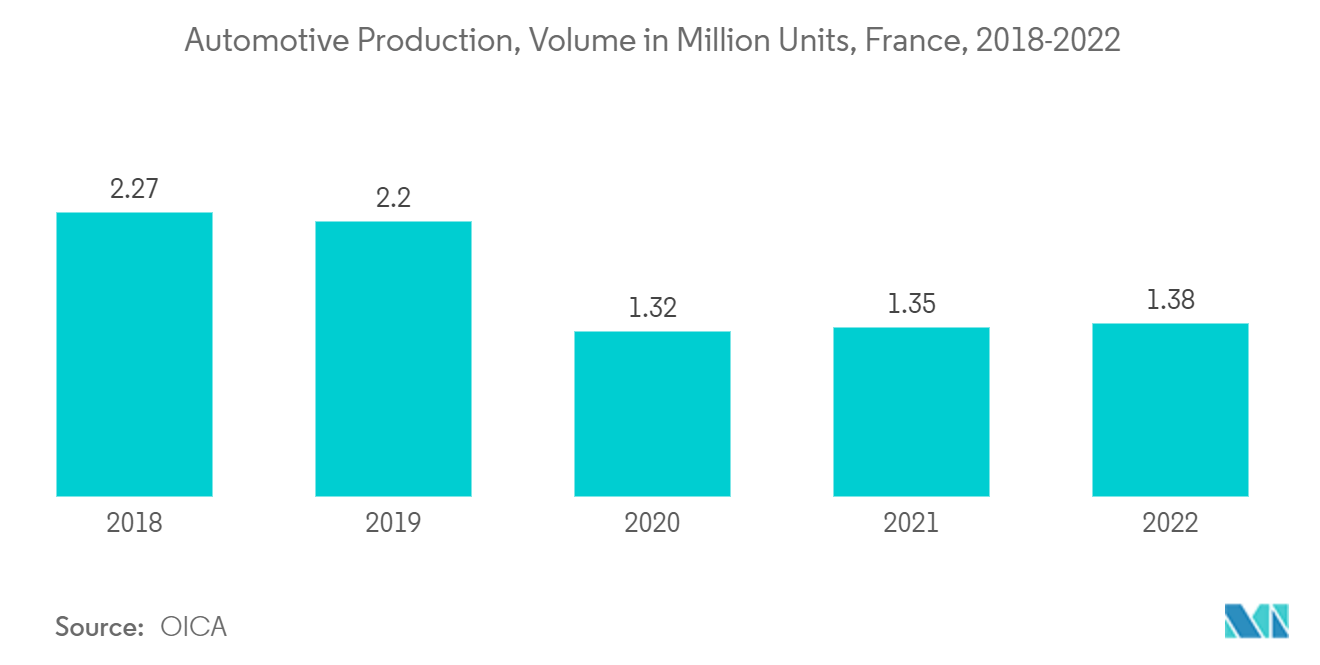Market Trends of France Silica Sand Industry
Construction Sector to Dominate the Market
- Silica sand is widely used in the production of mortars and concrete since it is the main ingredient of various construction materials, such as roofing shingles, mortars, asphalt mixtures, cement, and other flooring compounds.
- It is also used in public works construction, particularly tunnel construction, which implies the use of pneumatic and electric tools, excavation machinery, and concrete pouring. Moreover, it also finds application in the demolition of masonry and reinforced concrete structures, both manually and mechanically.
- The growing construction activities in France are a major consumption driver for silica sand. France has the second-largest construction industry in the European region. The construction index in the country has been witnessing slow growth, with a gradual increase in the industry turnover index over the past few years. The construction industry in the country recently gained momentum after eight long years of decline.
- According to the European Construction Industry Federation, the construction activity in France during 2021 experienced a substantial increase of 10.5% in volume after witnessing a downfall of 14.4% in 2020 owing to pandemic restrictions. In 2022, according to the Federation, the country witnessed a slow construction activity growth rate of 3.5% only. The total investment in construction in France in 2022 was EUR 355 billion (USD 391.16 billion).
- The Ministry of Ecological and Inclusive Transition revealed an increase in total building permits in France increased to 30,300 units in January 2023 from 33,000 units in December 2022. However, the sale of new homes got decreased to 27,900 units in January from 44,300 units in December of 2022.
- Additionally, the French government's initiatives to develop the city for hosting the 2024 Olympics are likely to drive the market. For instance, the French government sanctioned approximately USD 3.3 billion for the construction of the Hermitage towers (two 320-meter-1050-foot towers), which are due to be completed by 2024. The essential infrastructure for the Olympic event requires building 4,500 new dwellings for local people, 100,000 square meters for business activities, and 20,000 new hotel rooms for tourists.
- The French government announced several measures to promote residential construction as well as rehabilitation and maintenance. According to the European Construction Industry Federation, the housing rehabilitation and maintenance market registered a 1.8% increase in 2022, exceeding the 2019 levels. The growth in 2023 is also expected to remain steady at around 1.8 %. The energy renovation market is primarily driven by an increase in the credits allocated to the "MaPrimeRénov'" scheme, whose budget for 2023 is about EUR 2.5 billion (USD 2.75 billion).
- Consequently, the demand for silica sand from the construction sector in France is likely to remain steady during the forecast period as a result of the efforts and developmental activities undertaken by the government.

Glass and Ceramic Industry are among the Major End-User Industries
- Although silica sand is the primary raw material for glass manufacturing, only high-purity silica sand is used in the process. The reason for such demanding requirements is that the sand's purity directly impacts the transparency, strength, and durability of glass. For example, only glass products that are manufactured with high-quality silica sand can meet the optimal vision requirements for vehicle windshields.
- In glass manufacturing, high-quality silica sand makes up around three-quarters of the batch of raw materials used in the glassmaking process. The other quarter is made up of soda, limestone, and clarifying agents, along with a percentage of recycled glass.
- Silica sand finds application in the production of various types of glass, including flat glass, container glass, specialty glass, fiberglass, and others.
- According to Glass Alliance Europe, in 2022, France was the third largest producer of glass in Europe. Moreover, France accounts for 12% of the total flat glass production in the European Union. Glass is mostly used in the construction and automotive sectors in the country.
- The France automobile industry has fared much better when compared to other major economies in Europe in the past few years. In 2022, the country produced 1.38 million cars and light commercial vehicles compared to vehicles produced in 2021, indicating an increase of 2%. In 2021, the country produced about 1.35 million units of vehicles, about a 5% increase from 2020.
- According to the PFA Automobile Association, the French market for new passenger cars increased by 15.20% in the first three months of 2023, with 420,888 registrations. In the first three months of 2023, 509,251 new light vehicles (passenger cars and light commercial vehicles under 5.1 tonnes) were registered, representing an 11.65% increase over the same time period in 2022.
- Silica sand also finds applications in electronics as technical ceramics, where it is transformed into silicon through a complex process involving high temperatures and chemical reactions. The resulting high-purity silicon is used to manufacture integrated circuits and microchips in a wide range of electronic devices.
- In the electronics and semiconductors sector, France is focusing on bolstering semiconductor production to meet demand in the domestic market as well as catering to the demand in foreign countries.
- In July 2022, Franco-Italian STMicroelectronics and American GlobalFoundries announced plans to develop a facility in Crolles, close to Grenoble (Isère), with a EUR 5.7 million (USD 6.28 million) investment, at the "Choose France" investment event in Versailles.
- The plant will be located on a current STMicroelectronics property, which is the largest manufacturing location in France. The goal of this investment is to produce chips of various sizes and double present production levels.
- The automobile and electronics sectors combined will create positive demand for the silica sand market from the glass and ceramic production in the country over the forecast period.


